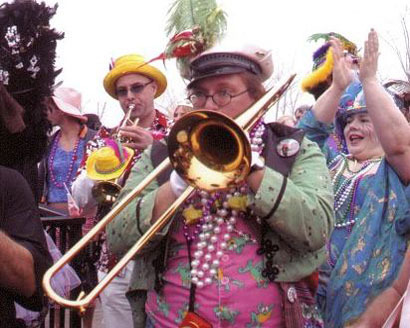The Food Almanac: February 12, 2013
In The Food Almanac, Tom Fitzmorris of the online newsletter The New Orleans Menu notes food facts and sayings.
Days Until. . .
Valentine's Day–2
Happy Mardi Gras!
It's Mardi Gras, a day with several eating traditions. The first is eating and drinking whatever you want. Meat and alcohol are both proscripted for the Lenten season that begins tomorrow. So we overindulge today.
The word "carnival" means "farewell to meat." My personal observance of this tradition involves eating a steak. And not just any steak, but a seriously large one of fine quality. I get it, in the company of anyone who cares to join me, at the Crescent City Steak House. I'll get there around two-thirty to begin the indulgence.
The strangest aspect of Mardi Gras is that, despite this emphasis on indulgence of the senses, it's the worst day of the year to eat a gourmet repast. If you can avoid going to a restaurant, it's a very good idea to do so.
Many other parts of the world have eating traditions on this day. The entire French-speaking world does, of course. The French connection is how Mardi Gras arrived in Louisiana. This is the day for pancakes in places that refer to this day as Shrove Tuesday–notably Liberal, Kansas. (See below.)
In Hawaii, the Portuguese presence in its past left behind a tradition of making malasada, a kind of doughnut. The Amish people in Pennsylvania Dutch country make fastnacht, a potato cake served with dark syrup today. In Iceland, they call this Sprengidagur, which translates as "Bursting Day." They they celebrate by eating peas and salted, cured meats.
Deft Dining Rule #158: If you can't let yourself have a Lucky Dog on Bourbon Street on Mardi Gras, you have no soul. If you let yourself eat a Lucky Dog any other time, you have no brain.
Food Calendar
It is International Lentil Soup Day. Lentils are an ancient part of the human diet, having been cultivated since prehistoric times in the Middle East. They have two things going for them: they're highly nutritious, and they taste great. Lentils are legumes, more closely related to chickpeas and green peas than to red beans, limas, or other New World beans. They come in many colors, from green to red to brown; the latter are most common in our part of the world.
Lentils lend themselves so well to soup that they are found in that role throughout the Mediterranean. I order lentil soup whenever we find it; after hundreds of samples, I can't say I've ever had a bad one. The best come from Italian and Lebanese restaurants. Lentils play a particularly large role in the Indian menu. Not only do they serve them as soups and as beans, but they also mill them into a flour that's made into poppadums, those big thin wafers you get at the beginning of an Indian dinner.
The unique shape of the lentil gave rise to the word "lens," with which it shares a shape. (I know that sounds unlikely, but it's true.)
The Old Kitchen Sage Sez:
When the cook in the house
Prepares lentils and fish
The reviews from the spouse
Are complimentary-ish.
Edible Dictionary
beurre noir, [buhr NWA], n., French. –Literally, "black butter." When butter is heated long enough that its solids have browned, it's not far away from becoming a sauce. All it takes is a little vinegar, Worcestershire sauce, or lemon juice. This is one of the two versions of what's commonly known around New Orleans as "meuniere sauce." It's used to finish trout meuniere at Galatoire's, for instance. Beurre noir is related to beurre noisette ("hazelnut butter," for its color). They differ only in color, which may not be enough to start an argument about. (Unless a participant in the argument is a French chef.)
Gourmet Gazetteer
Butterville, New York is in the Hudson Valley about eighty-five miles north of New York City, just outside New Paltz. There does appear to be some dairying going on there, but the main action is resort hotel called the Mohonk Mountain House, which one correspondent describes as "looking like the hotel in The Shining, but a lot more fun." You can eat there.
Food Inventions
Today is the birthday, in 1791, of Peter Cooper, a man active in everything from industry to politics to education. He built the first steam locomotive in the United States, the Tom Thumb. We remember him as having patented a gelatin dessert in 1845. After the patent expired, the concept evolved into Jell-O.
Food In Science
Today in 1976, FD&C Red Dye #2 was banned from use in food in the United States, after Russian scientists found it caused cancer in lab rats. As a result, we had no red M&Ms for many years. At the local level, Barq's Red Cream Soda became colorless for a time. There was no change in the flavor, but everybody said it did taste different. That dye was replaced by others that didn't cause problems.
Food Namesakes
Actor Joe Don Baker was born today in 1936. . . Sir Anthony Berry, British politician, was born today in 1925. . . Pro baseballer Chet Lemon stepped up to the Big Plate today in 1955. . . Former governor of Indiana Conrad Baker was inaugurated into life today in 1817.
Words To Eat By
"Kissing don't last: cookery do!"–George Meredith, British writer, born today in 1809.
Words To Drink By
"An American monkey after getting drunk on brandy would never touch it again, and thus is much wiser than most men."–Charles Darwin, born today in 1809.
"If this is coffee, please bring me some tea; if this is tea, please bring me some coffee."–Abraham Lincoln, born today in 1809.
